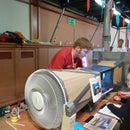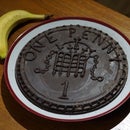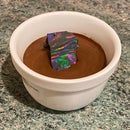Introduction: Mario Kart Costume
Hello!
This instructable documents the build of one of my favourite costumes ever...
My hockey club was taking part in a hockey festival with a 90s theme, so our team settled on Mario Kart.
I got to work building a wearable kart costume, but not before dusting off my N64 for some "research"!
Materials:
- Two 3m lengths of overflow pipe
- PVC weld
- Guttering offcuts
- Black electrical tape
- Some high density PUR packaging foam
- Assorted screws
- Two blue U-shaped travel pillows (I got these for £1 each in Poundland)
- Thick gauge modelling wire (or 2-3 wire coat hangers)
- The head from a small engine (could be made from cardboard)
- Scrap black plastic tube
- An old bike brake cable (or throttle cable)
- 2 matching red cocktail shakers (also from Poundland)
- A swimming float (also from Poundland)
- Red and silver spray paint (gold would have been useful for the wheels if I had some)
- A steering wheel (I 3D printed this but it could be taken from toy or be made from a lid for true hand tools only build)
- A pack of coloured sheets of craft foam (Yellow for buttons, red for M badge, blue for trousers)
- A blue sleeveless top and a red T-shirt
- White gloves, a suitable red cap (Mine had a Mario M on but this would be easy to add)
- 2 large black stick-on fake moustaches
Step 1: PVC Chassis
For the chassis, I used PVC overflow pipe. It is lightweight, tough and flexible enough to squeeze to grip the tummy when wearing it.
I worked out the rough shape and size I was looking for, measured and marked where I wanted the bends.
I then set up my heat gun, standing on its end, turned to about 20% on its temperature dial (gradually turn up from cold until it softens the PVC), and rotated the bend marks over the heat until the pipe softened. I then carefully bent it around the corner of a cardboard box for the 90 degree bends, and made the 45 degree bends by eye.
Be careful that the bend occurs where you want it as it can soften quite a length if you are not careful. Make sure you lay the chassis flat while each bend cools so the chassis ends up straight (other wise the kart would handle like Bowser's!). The ends can be easily cut with almost any kind of saw (I used a crosscut saw).
I used a halfmoon file to put a curve in the end of the pipe so it could be bonded with PVC weld to a straight cross bar at the back.
Using pipe fittings would have been easier and neater, but more expensive, and I think this worked just fine. 4 more straight cross members were made, two as axles and two to grip to front and back of the wearer. These I didn't bond with PVC weld, but screwed them in place. The axles need to be mounted on top, and I wasn't sure it would be strong enough for the tummy grip cross bars.
I also made the steering wheel tube with another piece of PVC, adding a 90 degree bend 5 cm from the end. This up bend was screwed to the front of the chassis and the main shaft was screwed to the top of the axle.
Step 2: Wheels
I searched around for anything the right shape and size for the wheels, but I couldn't find any pots or bottles, and I'd already come back from the plumbing shop so didn't fancy going back for larger pipe. I settled on using two pieces of left over guttering taped together with black electrical tape to make a tube for the outer 'tyre' surface, and some high density PUR packaging foam to close each end.
I cut one wheel width with a hack saw, and used this as a template for the other 7 so the widths would match. I then width matched pairs to minimise any variation, and taped them together with black 50mm wide electrical tape. Pressing this tube onto the packaging foam leaves a mark that can then be cut out. I then found a piece of aluminium tube slightly narrower than the PVC and cut a burr in with a hacksaw to act as a hole saw. I then spun this by hand to cut a hole in the foam to fit the axle. As you can see, I test fit the axles with gaffa tape before screwing the joints with self tapping screws.
Step 3: The Engine
Mario has a twin exhaust on his kart. While I was in Poundland (like a dollar store but 30% more expensive), I found some red cocktail shakers that looked pretty good as cartoon chunky exhausts. I used hot-melt glue gun to attach the lids upside down. I also attached some offcuts from the wheel foam to allow me to mount them. For the engine itself I found an old head from a mini moto engine, hot-melt glued and screwed it using large self tappers into a block of polystyrene I had painted silver.
I found a scrap of black plastic tube that self tapped when screwed into the spark plug hole, and through this I fed a piece of broken throttle cable from my Mini (an bike brake cable would also work). I cable tied this to the original exhaust port and the bend was sufficient for it to grip in the plastic tube, giving a convincing spark plug look.
The 'engine' and 'exhausts' were hot-melt glued to each other and glued and screwed to a corriflute package stiffener I had lying about. The hole assembly was later screwed to the chassis.
Step 4: The Legs
To give the legs shape, I ran some stiff modelling wire (wire coat hanger would also work) through the seam on end, up the cushion and into the shoe. The shoe can be hot-melt glued to a foam offcut and that glued to the chassis, constraining one end of the wire. For extra strength I tied the heels of the sneakers together with a twist tie. Bending a loop in the shoe gives more control as to how the leg leaves, and after bending a knee in the middle, the free end of the wire sticking out of the seam is wrapped around the cross bar, being careful that the end points away from the wearer’s body. The leg can then be shaped as required.
While a little fiddly, this was easy enough to do that I did a test fit before painting the Kart chassis. And didn’t mind repeating once painted.
Step 5: Painting the Kart
I sprayed a couple of coats of primer and then a couple of top coats.
The chassis including cross beams were painted red, as was the steering wheel column.
I sprayed the axles silver and, using a piece of plastic tube as a mask, sprayed the centres of the wheels silver too.
Once dry I assembled the wheels and axles onto the chassis. At this point I added a 3D printed steering wheel, though my original plan was a plant dish (pictured in the previous step, just needed by the plant I borrowed it from!). It could also have been taken from a toy, be a circular lid or be cut out of card or pretty much anything. My steering wheel fit over the tube and was screwed on from the side.
Step 6: Reassembling
Step 7: The Seat
The bottom part of the seat was wide enough to rest on the edges of the chassis where it narrows, and the back rested on the engine, meaning both were secure.
I also cut some blue craft foam to fit between the legs to make the top of the trousers. This was fitted and glued to the seat with hot-melt.
I then glued some grip mat (the stuff that is supposed to stop your phone slipping on your dashboard) over the cross beams to both cushion where the wire is wrapped and also give better grip on the tummy.
Step 8: Finishing Touches
I cut the M and the surrounding ring from red modelling foam and glued both to white card. I wedged another foam offcut into the end of the tube and glued the badge to it.
I cut two circles of yellow craft foam to make buttons so the sleeveless top I had would look more like cartoon dungarees.
I also shaped an upside down large fake moustache into a Mario moustache shape. I cut another in half for eyebrows.
I put the blue sleeveless top on over a red tshirt over a black underlayer. I rolled the top two up so they stopped at the kart, the break in colour helping the illusion of being in the kart.
Add a Mario style cap (the badge can be made the same way) and some white gloves and you are ready!
Step 9: The End Result
I was also pleased with how practical the costume turned out. Careful design and positioning of the tummy gripping cross bars meant that the kart was comfortable yet secure enough to move around without holding it. It was easily taken off when needed and just as easy to put back on.
The use of light materials such as the PVC chassis meant when the night moved on I could dance in it, and despite some not-so-sober dance moves it was robust enough to last the night. The view was also pretty amusing with the feet in front of me wherever I went.
If you make one be sure to let me know below.
Also if you like this please vote for me in the contests:)






